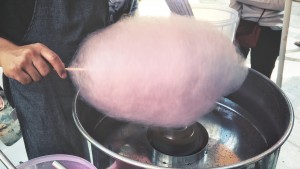What do cotton candy and regenerative tissue have in common? We know what you’re thinking – how in the world could a sweet, surgery treat have anything in common with something as complex as artificial human tissue? Researchers at Vanderbilt University recently demonstrated a link between the way this carnival staple is created and the successful growth of artificial human tissue. While the former satisfies our sweet tooth the later may save the lives of patients who have lost tissue due to accident or from disease.
candy and regenerative tissue have in common? We know what you’re thinking – how in the world could a sweet, surgery treat have anything in common with something as complex as artificial human tissue? Researchers at Vanderbilt University recently demonstrated a link between the way this carnival staple is created and the successful growth of artificial human tissue. While the former satisfies our sweet tooth the later may save the lives of patients who have lost tissue due to accident or from disease.
A roadblock often encountered when trying to successfully create artificial human tissue is the difficulty of incorporating capillaries into engineered tissues. These small branching blood vessels are ten times thinner than hair. Engineers Hak-Joon Sung, Leon Bellan and their team are in the process of researching how to solve this problem using fibers made from a plastic called poly(N-isoproplyarcylamide) (PNIPAM).
Capillary-sized polymer fibers were spun using a cotton candy machine — just think of how thin the strands of cotton candy are. Then, the team poured a hydrogel resembling clear jello over the fibers and heated them in an incubator. This made the inner polymer fibers essentially disappear, and what was left was capillary-like channels. This is possible because the hydrogel component and the poly(N-isoproplyarcylamide) component have different melting temperatures, which is discussed by Forbes.
PNIPAM is a hydrogel too, with the special property that it loses about 90% of its water when it hits 32 degrees C. At that point, the relatively weak bonds between water and the polymer can’t hold together anymore. That’s about 90 degrees F, or just under body temperature. So when the hydrogel scaffold heats up to the temperature cells like to grow, the fibers essentially disappear, leaving capillary-like channels behind.
This leaves behind the hydrogel component, which acts as a scaffold in which cells can live. The next step is to inject the scaffold with cells, preferably from a patient’s own body, such that they can grow healthy, repaired tissue.
Artificial tissue is currently a hot topic, and while 3D printing is making great strides in regenerative medicine, it presents setbacks specific to small scale needs. “3D printing certainly has its place for larger features, but I’m not aware of a 3D printing approach that’s able to produce features on a capillary scale in 3D,” Dr. Leon Bellan told Digital Trends.
There are still questions to be answered with this latest innovation. However, researchers are confident the future of artificial tissue could lead to the creation of full-scale organs, ending transplant waiting lists – how sweet is that?
